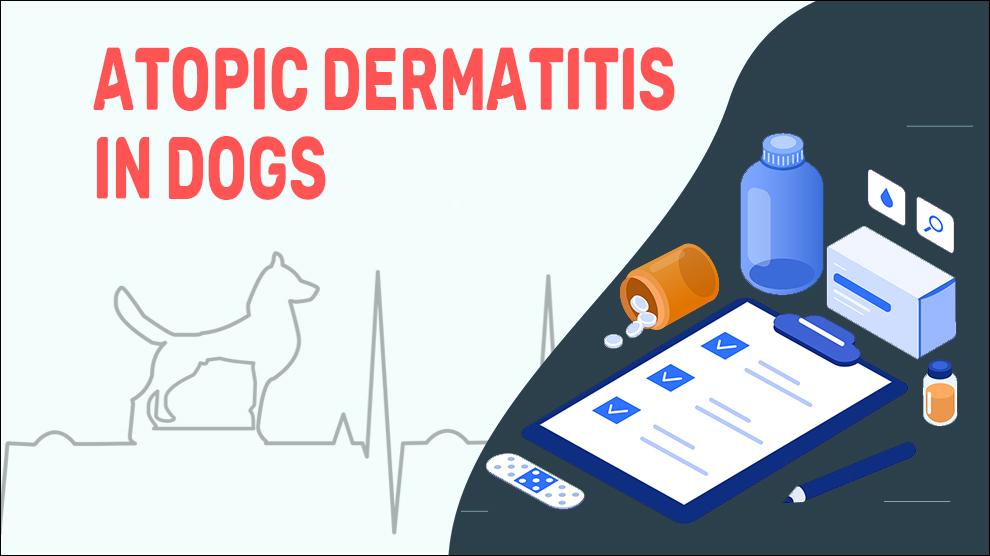What is Atopic Dermatitis In Dogs?
Canine atopic dermatitis (CAD) is a chronic, pruritic inflammatory skin condition that typically affects dogs’ at age 6 months to 3 years.
CAD is a hereditary predisposition develops allergic symptoms after frequent exposure to environmental allergens. This is also called as canine atopy and allergic dermatitis.
This condition develops pruritic inflammatory skin disease associated with elevated levels of immunoglobulin E (IgE), which typically target environmental allergens.
The disease is characterized by pruritus and lesion distribution can differ with the breed.
Primary lesions are rare and consist of small papules, erythematous macules and patches. Due to the presence of secondary infections, most lesions develop secondary to self-trauma. They include erythema, scaling, alopecia, hyperpigmentation, hemorrhagic crusts, excoriations and lichenification.
Symptoms Of Atopic Dermatitis In Dogs
These are the most commonly affected areas in dogs:
- Muzzle
- Around the eyes
- Ears
- Underbelly
- Armpits
- Groin
- Feet
- In between the toes
- Base of the tail
The symptoms include:
- Pruritus (Excessive Scratching, Itching, Rubbing, Licking)
- Reddening and thickening of the skin
- Papules and erythema may be present
- Greasy skin
- Patchy or inconsistent hair loss
- Yeast (Malassezia) infections of the ear
Treatment Options For Atopic Dermatitis In Dogs
- Antihistamines - Chlortrimeton, Benadryl, Atarax, Clemastine, Claritin and Zyrtec.
- Pruritus: pruritic skin disease via antipruritic drugs.
- Allergen-specific immunotherapy (ASIT): This is the only treatment available to change a pet's immune response to allergens and help recover the health of the immune system (vs. masking symptoms).
- Antibiotics and Antifungal Medications- are required to treat secondary infections.
- Corticosteroids and Immunosuppressive Agents- Cortisone (dexamethasone, prednisone, prednisolone) and Cyclosporine (Atopica).
Home Remedies For Atopic Dermatitis In Dogs
The best treatment for your pet will be based on what’s causing the itch. The quick fixes or just treating symptomatically without finding the source often leads to development of resistant infections and aggravation of the itch over time.
Discuss with veterinarian dermatologist for any home care specific to your dog’s situation.
This may include dietary changes, exercise, further medications to administer and future veterinary visits for treatments as needed.
How to Prevent Atopic Dermatitis In Dogs
- When you find out which substances your dog is allergic to, avoidance is the best method of control.
- It is best to avoid the allergen altogether. Pollens and dust ( use an air cleaner with a HEPA filter), Molds (place activated charcoal above the exposed dirt in your house plants or use a dehumidifier).
- Medicated baths: medicated baths (weekly or every other week) with medicated shampoos and antimicrobial and antifungal agents relieves injured skin and remove allergens that cause skin allergy flare-ups. Afterward, apply a rinse to prevent drying out of the skin and hair coat.
- Dogs with skin folds can be cleaned daily with a clean, damp cloth, shampoo, wipes, ointment, lotion, spray, skin cleanser, etc.
- Regularly brush the dog to reduce shedding. Consistent grooming spreads the skin's natural protective oils across the surface.
- Regular long-term use of moisturizing, cleansing and emollient products supports a dog's skin defenses and prevention of recurrence.
- Consult with your veterinarian dermatologist for hypoallergenic vaccinations.
Affected Dog Breeds Of Atopic Dermatitis
The age of onset is generally between 6 months and 3 years.
Golden Retriever, Labrador Retriever, Pit Bull Terrier, German Shepherd, English Bulldog, Boxer, Pug, Irish Setter, Dalmatian, West Highland White Terrier, Scottish Terrier, Wire Fox Terrier, Welsh Terrier, Boston Terrier, Cairn Terrier, Lhasa Apsos, Shih Tzu, Miniature Schnauzer
There is no sex predisposition.
Additional Facts On Atopic Dermatitis In Dogs
1. CAD is the second leading cause of allergic reactions in dogs, after flea allergy dermatitis (FAD).
2. CAD is a disease with a complex pathogenesis. Percutaneous sensitizations by allergens like environmental allergens and/or food allergies induces skin infiltration by various inflammatory cells resulting in activation of resident cells and local production of inflammatory/itch mediators.
3. Several factors can exacerbate CAD such as:
- Environmental factors (eg, pollens of trees, grasses and weeds, dust mites, and molds).
- Ectoparasites( flea allergies).
- Infection by bacteria/Cutaneous colonization(Staphylococcus pseudintermedius).
- Yeast (Malassezia pachydermatis).
- Epidermal barrier dysfunction - poor permeability barrier of skin allows for the entry of antigens producing inflammatory cytokines.
When To See A Vet For Atopic Dermatitis In Dogs?
If your pet is displaying any of CAD signs, it’s a good idea to head to your vet immediately so they can help you find the bottom of your dog’s itch.
Dog Food Suggestions For Atopic Dermatitis
Hypoallergenic diets:
‘Diagnostic allergy testing’ is the quickest and best way to determine which foods your dog may or may not be allergic.
Wheat, Dairy, beef are responsible for 75% of food allergies in dogs. Avoid these items.
Novel protein sources used in this diet include venison, rabbit, lamb, duck, etc are not usually found in pet food.
Carbohydrate sources include sweet potatoes, potatoes, canned pumpkin, peas, yams, etc.,
Hydrolyzed protein diets - protein source has been chemically reduced to small fragments.
Sample rice and chicken dog food:
- 2 cup white rice.
- 2 cup skinless, boneless cubed chicken.
- 3 tbsp canned pumpkin.
Boil the chicken pieces in a pot with water. Add rice to the water after some time. When this is fully cooked, simmer the ingredients. Add the pumpkin after the ingredients in the pot is completely cooled. Store it up to 5 days in a fridge and feed your pet as needed.
Conclusion
Controlling pet allergies and itching is frustrating and usually difficult for a pet parent but it’s even more so for veterinarian. We cannot stress this enough that allergies (especially environmental allergies) in pets are not curable, only controllable. Pet owners can treat the allergy symptoms with medications and take steps to avoid the allergen that triggers their dog’s allergy.

















